
The Commodore 64, also known as the C64, is an 8-bit home computer introduced in January 1982 by Commodore International. It has been listed in the Guinness World Records as the highest-selling single computer model of all time, with independent estimates placing the number sold between 12.5 and 17 million units. Volume production started in early 1982, marketing in August for US$595. Preceded by the VIC-20 and Commodore PET, the C64 took its name from its 64 kilobytes(65,536 bytes) of RAM. With support for multicolor sprites and a custom chip for waveform generation, the C64 could create superior visuals and audio compared to systems without such custom hardware.

The RadioShack TRS-80 Color Computer, later marketed as the Tandy Color Computer and sometimes nicknamed the CoCo, is a line of home computers developed and sold by Tandy Corporation. Despite sharing a name with the earlier TRS-80, the Color Computer is a completely different, incompatible system and a radical departure in design and compatibility with its Motorola 6809E processor rather than the Zilog Z80 earlier models were built around.

The Atari 8-bit family is a series of 8-bit home computers introduced by Atari, Inc. in 1979 with the Atari 400 and Atari 800. The series was successively upgraded to the Atari 1200XL, Atari 600XL, Atari 800XL, Atari 65XE, Atari 130XE, Atari 800XE, and Atari XEGS, the last discontinued in 1992. These all differ primarily in packaging, each based on the MOS Technology 6502 CPU at 1.79 MHz and the same custom coprocessor chips. As the first home computer architecture with coprocessors, it has graphics and sound more advanced than most contemporary machines. Video games were a major appeal, and first-person space combat simulator Star Raiders is considered the platform's killer app. The plug-and-play peripherals use the Atari SIO serial bus, with one developer eventually also co-patenting USB.

The VIC-20 is an 8-bit home computer that was sold by Commodore Business Machines. The VIC-20 was announced in 1980, roughly three years after Commodore's first personal computer, the PET. The VIC-20 was the first computer of any description to sell one million units. It was described as "one of the first anti-spectatorial, non-esoteric computers by design...no longer relegated to hobbyist/enthusiasts or those with money, the computer Commodore developed was the computer of the future."
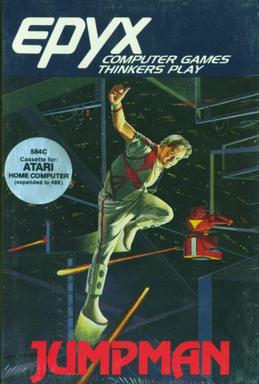
Jumpman is a platform game written by Randy Glover and published by Epyx in 1983. It was first developed for the Atari 8-bit family, and versions were also released for the Commodore 64, Apple II, and IBM PC.

Centipede is a 1980 fixed shooter arcade video game developed and published by Atari, Inc. Designed by Dona Bailey and Ed Logg, it was one of the most commercially successful games from the golden age of arcade video games and one of the first with a significant female player base. The primary objective is to shoot all the segments of a centipede that winds down the playing field. An arcade sequel, Millipede, followed in 1982.
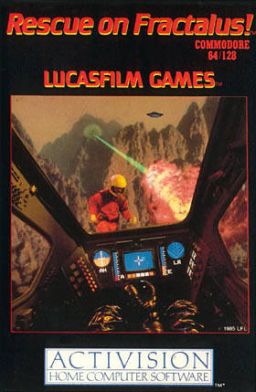
Rescue On Fractalus! is a 1985 first-person shooter computer game created by Lucasfilm Games. It was originally released for the Atari 8-bit family and the Atari 5200 games console. It was also ported to other popular platforms of the day, such as the Apple II, ZX Spectrum, Amstrad CPC, Tandy Color Computer 3 and Commodore 64. The game was one of the first two products from the fledgling Lucasfilm Computer Division Games Group led by Peter Langston. David Fox was the project leader and designer. Music was mainly composed by Charlie Kellner.
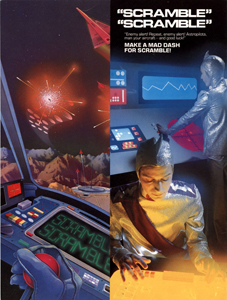
Scramble is a horizontally scrolling shooter arcade video game released in 1981. It was developed by Konami and manufactured and distributed by Leijac in Japan and Stern in North America. It was the first side-scrolling shooter with forced scrolling and multiple distinct levels, and it established the foundation for a new genre.
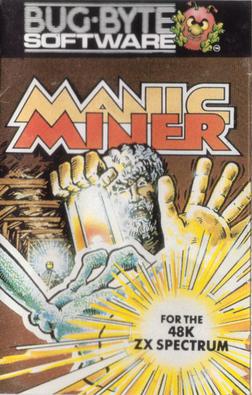
Manic Miner is a platform video game written for the ZX Spectrum by Matthew Smith. It was published by Bug-Byte in 1983, then later the same year by Software Projects. The first game in the Miner Willy series, the design was inspired by Miner 2049er (1982) for the Atari 8-bit family. Retro Gamer called Manic Miner one of the most influential platform games of all time, and it has been ported to numerous home computers, video game consoles, and mobile phones.

The VTech Laser 200 is an 8-bit home computer from 1983, also sold as the Salora Fellow, the Seltron 200 in Hungary and Italy, the Smart-Alec Jr. by Dynasty Computer Corporation in Dallas, Texas for the USA, the Texet TX8000A, and the Dick Smith VZ 200 and the VTech VZ 200.

Temple of Apshai is a dungeon crawl role-playing video game developed and published by Automated Simulations in 1979. Originating on the TRS-80 and Commodore PET, it was followed by several updated versions for other computers between 1980 and 1986.

The Sentinel, released in the United States as The Sentry, is a puzzle video game created by Geoff Crammond, published by Firebird in 1986 for the BBC Micro and converted to the Commodore 64, Amstrad CPC, ZX Spectrum, Atari ST, Amiga and IBM PC compatibles. The Sentinel was among the first games to use solid-filled 3D graphics on home computers. It won numerous awards upon release and has since appeared on several "best video games of all time" lists.

Sea Dragon is a horizontally scrolling shooter for the TRS-80 computer, written by Wayne Westmoreland and Terry Gilman, and released in 1982 by Adventure International. The gameplay is similar to the Scramble arcade game, but underwater. It was ported to the Apple II, Atari 8-bit family, Commodore 64, TRS-80 Color Computer, and DOS.
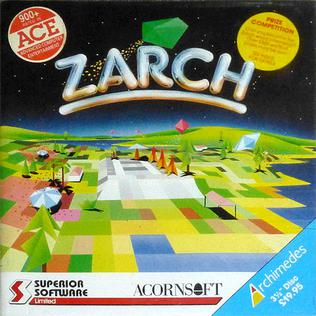
Zarch is a computer game developed by David Braben in 1987, for the release of the Acorn Archimedes computer. Zarch started off as a demo called Lander which was bundled with almost all releases of the Acorn Archimedes.

Navy SEALS is a shoot 'em up platform video game developed and published by Ocean Software. It was first released in the United Kingdom for the Amstrad CPC, Amstrad GX4000 and Commodore 64 in 1990. It was later re-released in the rest of Europe for the ZX Spectrum, Atari ST and Amiga home computers in the following year. It was then ported to the Game Boy on 1 September 1991 in the United States. The game is based on the film of the same name and follows the protagonist, Lieutenant Dale Hawkins, progressing through five side-scrolling levels.

Time Bandit is a maze shoot 'em up written for the TRS-80 Model I by Bill Dunlevy and Harry Lafnear and published by MichTron in 1983. It was ported to the TRS-80 Color Computer and Dragon 32, but enjoyed its greatest popularity several years later as an early release for the Atari ST. It was also released for the pseudo-PC-compatible Sanyo MBC-55x with 8-color display. Amiga and MS-DOS versions were ported by Timothy Purves.

Sanxion is a horizontally scrolling shooter developed by Stavros Fasoulas for the Commodore 64 and published in 1986 by Thalamus Ltd. It was the first game released by Thalamus. A ZX Spectrum port followed in 1989. Fasoulas also wrote Delta and Quedex.

Dropzone is a horizontally scrolling shooter developed by Archer Maclean for the Atari 8-bit family and published in 1984 by U.S. Gold. It was ported to the Commodore 64, and later released for the Nintendo Entertainment System, Game Boy, Game Gear, and Game Boy Color.
The ColecoVision, SG-1000, CreatiVision, and first-generation MSX computers use the TMS9918A Video Display processor (VDP), which has its own 16 KiB of video memory that was not shared with main memory. Compared to the unified system and video memory used by other 8-bit computers of the time, such as the Apple II, ZX Spectrum, and Commodore 64, separate memory has the advantage of freeing up of the Z80 processor's 64 KiB address space for main RAM, and the VDP does not need to steal CPU cycles to access video memory. The disadvantage is that the program has to use the CPU's dedicated I/O instructions to command the VDP to manipulate the contents of the video RAM. This not only slows down video access but also makes the porting of games from unified-memory platforms more difficult. Attempts of porting ZX Spectrum games were often thwarted by this difference. Also, programmers had to learn to optimally use the more advanced capabilities of the VDP.
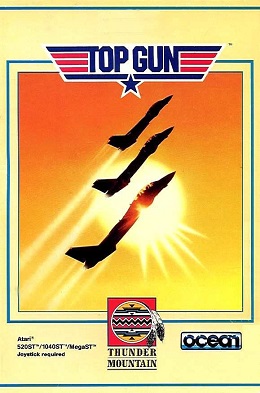
Top Gun is a 1986 combat flight simulation game based on the film of the same name. It was developed and published by British company Ocean Software, and was released for several computer platforms. In the United Kingdom, it was released for Amstrad CPC, Commodore 64, and ZX Spectrum in December 1986. The following year, it was released for Atari ST. In the United States, it was published by Thunder Mountain. In 1989, it was published by The Hit Squad as a budget re-release for ZX Spectrum and Commodore 64.



















